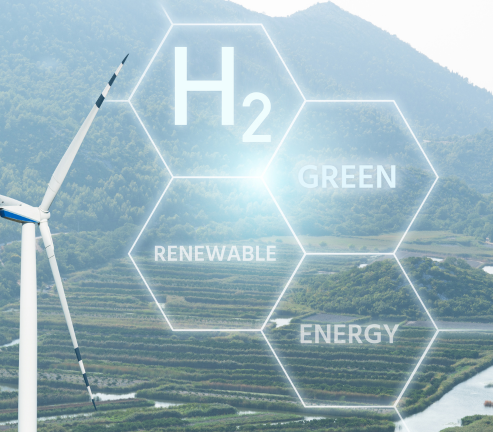Hydrogen Safety & Security

The Safety Imperative
The hydrogen industry’s safety performance is paramount for ensuring its credibility across a wide range of applications. At AcuTech, we recognize Process Safety Management (PSM) as the global standard for effectively managing catastrophic risks, particularly in chemical-related operations similar to those involving hydrogen. While not all operations are subject to PSM regulations, our voluntary adoption approach to PSM ensures benefits for all stakeholders, irrespective of regulatory requirements. AcuTech is uniquely positioned to provide expert guidance on the safe production, storage, handling, and utilization of hydrogen as its prevalence continues to grow.
Our Approach to Safe & Secure Hydrogen
We understand the importance of a disciplined approach to achieving process safety excellence, which is why our services emphasize modern PSM frameworks and internal compliance with standards and practices. As the hydrogen industry continues to evolve, safety and effective management systems remain essential for its sustained success, and AcuTech is here to support you every step of the way.

Whether you produce grey, brown, blue, green or white hydrogen, AcuTech strongly recommends aligning to the core elements of process safety management for all facilities. AcuTech collaborates closely with each client to conduct risk assessments, utilize consequence modeling and analysis, and design innovative management systems and safety protocols to protect lives, assets, the environment, and the global economy.
Hydrogen Industry Consortia Involvement
To ensure the most effective support for our clients, AcuTech has forged relationships with international organizations and academic centers to remain at the forefront of hydrogen risk assessment. In recent years, AcuTech has proactively been involved with industry consortia to help advance the safe and effective use of hydrogen as part of the energy transition.
As a member of the Center for Hydrogen Safety (CHS)’s Executive Committee, AcuTech’s consultants are up to date on global safety information and guidance. Mr. David Moore serves as the Chairman of the Managing Board for CHS as well as a member of the Hydrogen Safety Panel for the U.S. Department of Energy. AcuTech is also a member of the Fire and Blast Information Group (FABIG), which provides a platform for critical technical information sharing among operators and researchers on the latest experience and research on hydrogen risks.

Recent Hydrogen Projects
- 2024 – AcuTech is conducting a Quantitative Risk Assessment of large-scale liquid hydrogen (LH2) installation being designed for installation in the USA. The project includes Frequency Analysis, Consequence Modeling, and Impact Analysis specific to hydrogen fire and blast risks.
- 2023 – AcuTech’s Quantitative Risk Team completed a Quantitative Risk Assessment of the first PEM electrolyzer installed by Amazon. The PEM electrolyzer produces low-carbon hydrogen to fuel more than 225 hydrogen fuel cell-powered forklift trucks at the site in Colorado, USA. The QRA leveraged numerous industry data sources and models to complete a novel assessment for this first-time installation, including Hazard Identification, Frequency Analysis, Consequence Modeling, and Impact Analysis. The study assessed the risks of confined vapor cloud explosions in the PEM electrolyzer using a combination of the latest consequence models (DNV Phast, Sandia’s HyRAM+), customized hydrogen blast modeling, the latest hydrogen equipment failure rate data (Sandia), integrated into a custom dynamic fault tree analysis. Risk results were developed for the site, including societal risk, individual risk, geographic risk contours, and FN Curves.
- 2023 – AcuTech’s Quantitative Risk Team completed a facility siting study update for a chlorine manufacturing facility that is expanding their operation to include hydrogen storage, and export for fueling. AcuTech conducted a previous facility siting study for the plant, and this update focused on the new risks. The study evaluated the risks and impacts of the new hydrogen compression, liquefaction, storage, and loading facility on the existing plant’s occupied buildings. AcuTech completed consequence modeling of hydrogen fire and blast hazards, as well as impact analysis to advise the site on mitigation plans and siting of the new process and the existing occupied buildings.
- 2023 – AcuTech’s Quantitative Risk Team and Fire Protection Team conducted a hazard review and consequence analysis of the first hydrogen bus refueling station for NEOM in Saudi Arabia. The team reviewed the proposed siting, design, and installation of the station against the requirements of NFPA 2, and conducted consequence modeling to evaluate the potential hazards of fire and blast. AcuTech facilitated a hazard identification (HAZID) of the hydrogen refueling equipment and operating procedures to review the hazards and ensure appropriate risk mitigation measures.
2023 – AcuTech’s Quantitative Risk Assessment Team assisted a chemical manufacturer with assessing and mitigating a confined explosive hydrogen atmosphere in a batch chemical reactor. The analysis included study of the confined vapor cloud explosion hazards, including the effects of deflagration venting, following the guidance and requirements of NFPA 68. - 2023 – AcuTech was contracted by a hydrogen development and production company to perform expert reviews of safety and fire protection assessments for a proposed hydrogen generation project in the USA. AcuTech reviewed and provided expert guidance on the project’s facility siting analyses, and compliance with fire protection codes, including NFPA 2.
- 2023 – AcuTech’s Quantitative Risk Assessment Team evaluated the siting of hydrogen and acetylene storage at a gas production and distribution facility in Mississippi, USA. The analysis included hazard identification and scenario development, release and dispersion modeling of LH2 and acetylene, vapor cloud explosion modeling, and jet fire modeling to assess impacts to onsite occupied buildings.
- 2022 – AcuTech’s Quantitative Risk Assessment Team assisted a chemical manufacturer with the installation of hydrogen processes into a laboratory, pilot plant, and small batch manufacturing facility. AcuTech conducted computational fluid dynamics (CFD) modeling and ventilation assessments to optimize the layout of hydrogen gas detectors and ensure define ventilation requirements to mitigate explosion hazards in processing areas, following guidance and requirements of NFPA 69.
- 2021 – AcuTech supported a chemical manufacturer to evaluate and define hazardous area electrical classification (HAEC) under the National Electric Code, NFPA 70, for the installation of hydrogen processes into a small batch manufacturing facility.
- 2019 – AcuTech completed consequence-based facility Siting Studies for nine (9) specialty chemical plants throughout North America. The hazards included potential releases of chlorine and hydrogen. Techniques included development of release scenarios; release, dispersion, and ingress modeling; occupied building impact analysis; and development of sound, engineering-based recommendations to address major risk drivers.
- Risk assessments (QRAs, security threats) and management
- Hydrogen security planning, whether physical or cybersecurity
- Hydrogen dispersion modeling
- Electrolyzer installation risk analysis
- Liquid hydrogen tank installation risk analysis
- Asset and mechanical integrity program planning
- Process hazard analyses (PHA)
- Transportation risk assessment
- Physical and cybersecurity
- Emergency management
- Critical infrastructure assessments and protection
- Consequence modeling
- Facility siting
- Training: Hydrogen Safety & Design
AcuTech’s consultants are well versed in codes and standards developed by industry bodies and will refer to these as well as each client’s local jurisdiction codes and standards. A sampling of the relevant codes and standards can be found below.
- NFPA 2: Hydrogen Technologies Code. Provides comprehensive requirements for the safe use of hydrogen in various applications, including stationary, mobile, and portable systems. It covers storage, handling, and utilization of hydrogen, aiming to mitigate potential hazards and ensure fire safety.
- NFPA 55: Compressed Gases and Cryogenic Fluids Code. Addresses the safe storage, handling, and use of compressed gases and cryogenic fluids, including hydrogen. It establishes guidelines for the design and operation of facilities storing and handling these substances to prevent accidents and protect personnel and property.
- NFPA 101: Life Safety Code. Sets standards for the design, construction, operation, and maintenance of buildings to ensure life safety. While not specific to hydrogen, it includes provisions relevant to the safe occupancy of buildings where hydrogen-related activities may occur, such as evacuation procedures and fire protection measures.
- NFPA 13: Standard for the Installation of Sprinkler Systems. Provides requirements for the design and installation of automatic fire sprinkler systems. While not hydrogen-specific, it may apply to facilities where hydrogen is stored or used, ensuring adequate fire protection measures are in place to mitigate fire risks.
- International Code Council (ICC) International Fire Code (IFC). Includes regulations related to hydrogen storage, handling, and use to ensure fire safety.
- American Society of Mechanical Engineers (ASME) Boiler and Pressure Vessel Code (BPVC). Contains standards for the design, construction, and inspection of pressure vessels, including those used in hydrogen storage.
- International Organization for Standardization (ISO) 19880 series. Provides guidelines for the safe storage and handling of hydrogen in stationary applications.
- European Union (EU) Directive 2014/68/EU. Sets requirements for the conformity assessment of pressure equipment, including hydrogen-related components.
- International Electrotechnical Commission (IEC) 62282 series. Specifies safety requirements for fuel cell technologies, including those used in hydrogen-powered vehicles.
- Occupational Safety and Health Administration (OSHA) regulations. Include general industry standards and guidelines applicable to workplaces handling hydrogen, ensuring worker safety.
AcuTech’s President & CEO, David Moore, is the current Chairman of the Managing Board of CHS (2024-2025) and was selected by the U.S. Department of Energy (DOE) to serve on their Hydrogen Safety Panel.

Learn the importance of global PSM application for hydrogen, including successful case studies, available frameworks, and potential safety enhancements.
